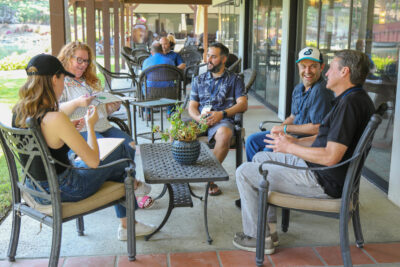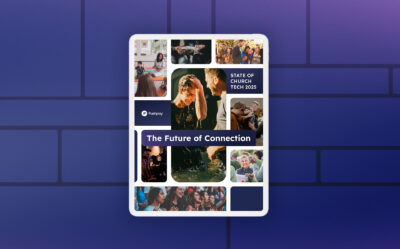
Q&A with Rick Holliday: How North Point Church Onboards New Staff
Rick Holliday of North Point Church sat down with Tobin Perry to discuss his church's process for preparing new staff members. Read the Q&A here.
Started 21 years ago by Andy Stanley, North Point Community Church is one of the largest and fastest-growing churches in America. Few churches have a more unique and significant church culture than North Point. As they’ve brought new staff on board, they’ve had to continually refresh their methods of assimilating them into the broader church culture. Rick Holliday (@rickholliday), North Point’s executive director of ministry services, recently sat down with Tobin Perry to describe their process for onboarding new church staff.
Tobin Perry: When you bring on a new staff member, what are some of your goals for the onboarding process?
Rick Holliday: Our primary goals are at least twofold. First, we have a very distinct DNA organizationally, and we want to transfer and infiltrate as much of that DNA of the organization into a new staff member, as quickly as possible. Then the other piece, obviously, is we hire people to do specific tasks. We want to make sure we’ve given them all the job skills they need in order to do what we’ve hired them to do and do that as quickly as possible.

Tobin Perry: What does the onboarding process look like for North Point?
Rick Holliday: Once we’ve made the decision to hire someone, the process begins slightly before the person’s first day at work. We have a website that tells you what you need to know before you get here and what you need to know in your first week, your first month, your first quarter, and your first year on the job. We give people a list of resources we think are time-appropriate for them as they get here. It’ll include items like, what the dress code is, what the hours are, what their schedule will be, and where the bathrooms are. People can look at those things beforehand in order to try to get comfortable before they arrive.
Our process is somewhat centralized and also somewhat decentralized. Each team has a different mechanism for onboarding new church staff and getting them comfortable with the role. Obviously, there’s introduction of team members. Most teams have a buddy system, where there’s a person who walks with you for the first week or two, can answer all of your questions, and then will give you specific job training.
Then, about three times a year, we have our new-hire orientation training. We call it “Align.” It’s a two-day event where senior leadership from the organization talks on a bunch of different topics that are culturally very relevant to us as an organization. Andy does the opening and the closing session. I lead a session. Some of our lead pastors lead sections on different topics we feel are helpful for everybody who is a staff member of our organization. A person could be fully onboarded within a couple of months. It may take six months just because of the nature of their job.
Tobin Perry: What are some of the mistakes that North Point has made when onboarding new church staff that has informed your process?
Rick Holliday: We’re 21 years old. I’d say, we started with people who were very, very culturally aligned. When we hired, we were hiring people who were very much like ourselves, initially. I think the biggest mistake we made was assuming that could go on forever. We now have more than 600 employees. The very organic process that we used for the first 10 years became more inconsistent. We didn’t have a centralized onboarding system like we have now with Align. We realized, though, there were gaps, because we were letting each department or each campus do their own process. We were getting inconsistent results. I would say we waited too long to figure out what elements we needed to centralize, and what elements should be left decentralized because they’re best handled organically and locally.
Tobin Perry: If you were starting an onboarding system from scratch today, how would you go about doing it?
Rick Holliday: I’d figure out the unique cultural elements and processes of our organization that we want to transplant—those things we want to make sure everyone understands within their first 90 days or so on the job. Then I would figure out the best way to communicate those elements. In a small church, it might just be some books that you would read together or some outlines you develop and share over lunch. Most churches won’t have 30 to 40 new staff in those meetings. It’ll be one or two. So for example, you could do what we used to do. Andy would actually sit with some of our new staff, and we would give them some information and give them a chance to ask questions.
I think the smaller you are, the more informal the process can be—informal but comprehensive. You want to make sure you’re doing it in a very relational manner, but you’re also making sure that the topics you’re covering are topics that are useful for people on the team to have.
Then the other thing I would recognize is there’s a pretty small amount of stuff that absolutely everyone needs to know their first week on the job. I would say, make sure that you’ve got some kind of staging in your information dissemination so you recognize that, once somebody’s been there for three months, the honeymoon’s over a little bit. Now they have some real-world issues.
Now it’s time for another bit of information to get dropped on them. It helps them process. You need some sort of gradual release of information that’s appropriate for the time they’ve been in the organization. I’d design that into the program.
Tobin Perry: Does your process at all look different if a person is a part of the ministry staff or the support staff or is it similar?
Rick Holliday: For the centralized components, no, it doesn’t. For the individually focused stuff, of course, it does. So in other words, my facility team has completely different training than our children’s staff team. But we really don’t distinguish between ministry and support staff. We really just talk about staff. We talk about every person has a role and all of those roles are critical for us to pull off what we do on Sunday mornings and during the week.
Tobin Perry: Do you guys discuss social media use in your onboarding process?
Rick Holliday: We have a personnel manual, a policy manual, that touches on some issues that we know have been a concern historically. One of those is use of social media. Without going into the exact policy, it essentially is to remember that you represent the organization in your personal life, in your social-media expression, whether you intend to or not. It’s almost impossible to divorce your personal opinions from your role on staff, so you’ve got to use that platform responsibly and not inconsistently with the views and the policies of the organization.
That’s all spelled out in a policy manual.
Tobin Perry: Is there anything else about onboarding new church staff that you want to mention that I didn’t ask?
Rick Holliday: Our end goal for every employee in our organization is for them to look back on their time in our organization and think it was the best job they ever had. Our onboarding process is the beginning of that. We tell employees that. We tell them we want to treat them really, really well, and we want them to think that it’s the best job they’ve ever had. Our goal is to live up to that from a management and a culture creation point of view. That’s a key distinctive of ours in the process.
This interview has been edited for clarity, grammar, and length.





